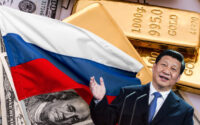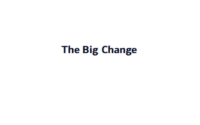Bond Traders See Fed Rate Hikes Ending Soon as Bank Stress Grows
(Bloomberg) — Bond traders Friday all but abandoned wagers that the Federal Reserve will raise interest rates in May and added to bets that its next shift will be a rate cut as early as June as the US approaches a recession.
Most Read from Bloomberg
While the fever ebbed over the course of the day, renewed concern over the banking sector spurred demand for safe assets and conviction that central banks will have to switch their focus to financial stability from inflation. US Treasury two- to 10-year yields fell to the lowest levels this year, the two-year as much as 28 basis points. The US yield declines were pared after a set of economic activity gauges for March were stronger than expected.
The swap market for wagers on the outcomes of specific Fed meetings at one point fully priced out a quarter-point rate increase in May, which was deemed likelier-than-not earlier this week. Swap rates continue to anticipate cuts totaling about a percentage point by year-end, setting up a confrontation with the central bank. Speaking after the Fed raised rates Wednesday for the ninth time, Fed Chair Jerome Powell said cuts were not his “base case.”
Investors turned to havens as bank shares slumped, after Bloomberg News reported Credit Suisse Group AG and UBS Group AG are among lenders under scrutiny in a US Justice Department probe into whether financial professionals helped Russian oligarchs evade sanctions. Deutsche Bank AG’s shares slumped as much as 15%, the most since March 2020. Treasury Secretary Janet Yellen convened the heads of top US financial regulators Friday morning for a previously unscheduled meeting of the Financial Stability Oversight Council.
“We do think that this may have been the last rate hike in this cycle,” Kelsey Berro, a JPMorgan Asset Management fixed-income portfolio manager, said on Bloomberg Television. “The 2-year yield is telling you just as much.”
Deutsche Bank became the latest example of banking turmoil in Europe as it announced a plan to repurchase debt, a move normally seen as a sign of strength. Analysts struggled to explain the selloff, which prompted German Chancellor Olaf Scholz to publicly back the lender.
Traders also on Friday reduced bets on additional monetary tightening by other major central banks, pricing out additional quarter-point hikes by the European Central Bank and the Bank of England.
“Emergency conditions continue into the weekend for the third time this month,” Jim Vogel, an analyst at FHN Financial said in a note. “We’d love to predict quarter-end might bring some stability — or at least smaller daily yield ranges for bellwether Treasuries. Instead, bank angst is likely to continue for financial stocks and interest rates.”
The spread between 5- and 30-year US Treasury yields jumped to a one-year high of 37.4 basis points, with the steepening a signal of investors expect the Fed to pivot soon to cutting rates.
The spread between 2- and 10-year Treasury rates, which has been inverted consistently since July, has steepened sharply as well. Two-year yields exceed 10-year yields by about 35 basis points, compared to as much as 111 basis points on March 8 — the extreme for this inversion cycle.
Friday’s moves extended a rally in bonds ignited by the first US bank failures since 2008 and the government-brokered rescue of Credit Suisse last weekend. It gathered pace on Wednesday after the Fed tempered its language around how much additional tightening it might do, even as it delivered another quarter-point hike.
Federal Reserve Bank of Atlanta President Raphael Bostic said Friday the decision to raise rates this week in the midst of a banking crisis was not taken lightly.
Fed’s Bostic Says Rate Decision Came After ‘a Lot of Debate’
Some strategists wagered the swoon in rates and steepening of curve have gone too far, with a team at Barclays Plc recommending a trade that will profit from a reversal.
For the moment that view is a tough sell. Mark Grant, chief global strategist at Colliers Securities, said in a note to clients Friday that “The Fed should just stop!” Jeffrey Gundlach, DoubleLine Capital LP’s chief investment officer, said yesterday on Twitter that he sees the Fed cutting rates “substantially soon.”
Gundlach Joins Powell-Is-Wrong Chorus Predicting Rate Cuts
“It’s a time of white-knuckling in these markets,” said Ed Al-Hussainy, a rates strategist at Columbia Threadneedle Investments. “It’s hard to catch this falling knife right now and not get stopped out a day later.”
The steepening in some sectors of the yield curve over the past 20 days “is not something we have seen outside of a small number of nasty environments,” Al-Hussainy said. His particular focus was on the gap of 2-year Treasury yields over rates on 30-year bonds, which was only about 14 basis points late on Friday, versus as much this year as 120 basis points in early March.
While two-year yield was down just 6 basis points in late US trading, its nearly 30-basis-point daily range was the 12th straight of 20 basis points of more, double last year’s median.
–With assistance from James Hirai, Aline Oyamada and Alice Gledhill.
(Adds analyst comment in 8th paragraph, updates yields throughout.)
Most Read from Bloomberg Businessweek
©2023 Bloomberg L.P.
[ad_2]
Source link


